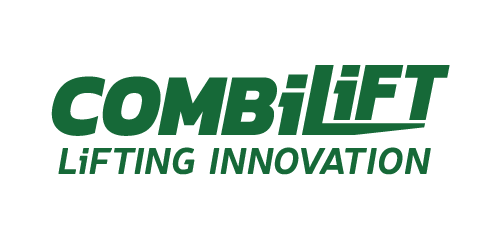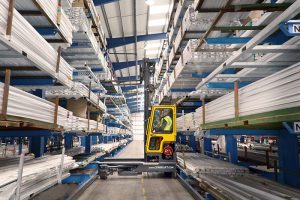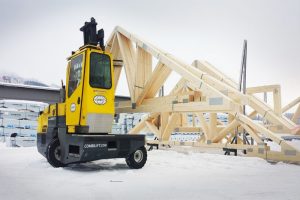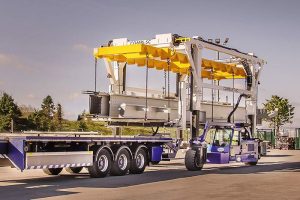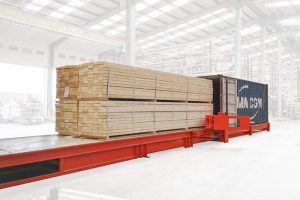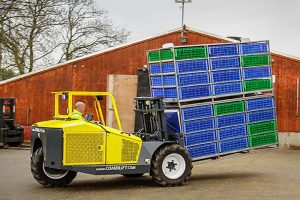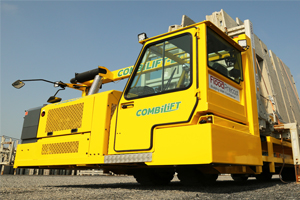Heavy industry requires heavy handling equipment. When it comes to moving bulky equipment parts – such as bodies for dump trucks or dipper buckets used in drag lines – mining companies often rely on the external hire of cranes to do their heavy lifting. But this approach comes with a host of challenges, such as increased safety and skills requirements, and limitations around the accessibility and manoeuvrability of cranes onsite. Which is why many Australian customers in the heavy industry segment are turning to engineered mobile carrier solutions to handle their large loads.
This article discusses the pain points those within the mining and heavy industry sector face when lifting and moving oversized, heavy parts, and provides an insight into how Combilift’s customised carrier solutions can address those issues. It also spotlights Newcastle business NWC, and how a customised Mobile Gantry machine from Combilift has improved their onsite efficiency and availability to a key mining client.

A HEAVY ISSUE
The heavy industry segment of Australia is one of the country’s most important. It accounts for 9 per cent – approximately $180 billion per year – of the Australian economy. With global infrastructure projects on the rise, demand for mined resources and products such as cement, aluminium and steel will increase in tandem with that progression. As will the need for construction and mining equipment – with Frost and Sullivan forecasting significant growth over the next 10 years.
One of the challenges that the heavy industry sector faces is the movement of hefty loads such as equipment parts, pre-cast concrete or large-scale structural steel. Specialised machinery is required for these tasks, and companies often hire lifting equipment such as cranes to do the job. But there are a number of limitations and drawbacks in hiring such equipment, as industry expert Jarad Wilson points out. “Cranes with the capacity to lift 30 tonne loads or over need significant counter-balance weight and therefore require a large footprint to work in, as well as multiple people to assist in preventing the load from swinging around,” explains Jarad, who is the Combilift National Product Manager for Straddle Carrier and Mobile Gantry machines. “Relying on external parties for heavy lifting operations can be highly inefficient compared to the ability to do this independently in-house.” Jarad cites availability, operating hours, and delays as common issues when it comes to external hire.
“Obviously companies need to work within the operating hours of the hire company, which means they often can’t guarantee availability at short notice. Additionally, when multiple parties are involved, the timeline of a job will be affected – it’s not unusual for individuals to run late, and that lost time spent waiting for equipment to arrive often equates to a loss in productivity. Not to mention weather issues – a windy day may disrupt or even cause a job to be postponed,” Jarad expands. “Also, when it comes to the size and bulk of a crane with an extreme load capacity, the requirements from a safety, labour and structural perspectives are huge. This can also result in major interruptions to day-to-day business and therefore impact on service to customers.” Notwithstanding the above issues, hiring heavy-lifting cranes incur weighty costs.
Those costs are not just capped with the machine hire itself but the corresponding crew. “When you have a crane onsite to move a bulky load, there are a number of people required, there’s the skilled person to operate, then the personnel who help with the other aspects of movement,” Jarad says. “Visibility is key with moving these types of loads, so additional crew is required. The site usually pays for these external crew with the hire but may also need to allocate their own staff to the job – all of this adds to the cost tally.” Manoeuvrability, or rather the lack of it, poses another problem. “This is where our mobile lifting solutions such as the heavy duty Combilift Straddle Carrier or Mobile Gantry machines are suited,” Jarad elaborates. “They have several steering options that gives the vehicle greater manoeuvrability in a tight space, including the ability to spin in the one position. We generally use multipoint lift to reduce load sway or unwanted movement which enhances the safety while manoeuvring. They also can be remote controlled, allowing the operator to move around to get better, all-round visibility from various angles. Overall, they are significantly safer, more controllable and far more efficient than a crane with a single lifting point.”
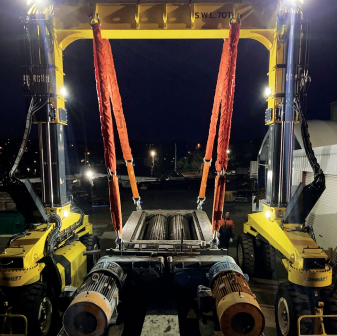
ENGINEERED AND CUSTOMISED MOBILE SOLUTIONS
The Combilift four- and eight-wheel Straddle Carriers (SC-4 and SC-8 respectively) and Mobile Gantry (MG) machines are what Jarad refers to as “engineered solutions” that are designed to handle and mobilise the extreme loads that are intrinsic to heavy industry. “When we talk about engineered solutions, we’re incorporating those key aspects of load handling efficiency, which include manoeuvrability, steering capability and how the vehicle is operated and controlled,” explains Jarad, who is also a mechanical structural engineer. “With all our customers, we first discuss the loads that they are dealing with and how that load will interact with the machine, then we marry up the right system with that requirement.”
Straddle Carriers have multiple connection points for lifting, while Mobile Gantry machines have a single beam across the top and are suited to single point lifting. The steering system on both these machines is a particularly noteworthy feature. “Unlike a forward and back steering system which is typical to two-wheeled vehicles, these machines offer several steering options, including crab steer – which is steering in one direction – front and rear only wheel steer, four-wheel steer and carousel steer, which allows the machine to pirouette,” Jarad expands. “These options provide greater flexibility which translates to increased manoeuvrability, especially in tight spaces where it’s imperative to have greater manoeuvrability with less travel.” Importantly, the Combilift Straddle Carrier 4-wheel (SC[1]4), SC-8 and MG machines are all customisable.
In fact, the machines are only made to order. “These machines for heavy industry are all highly bespoke, tailor-made units,” highlights Jarad. “We engineer a solution that is far more advanced than a single crane hook.” This is a point of difference that Combilift is able to offer the heavy industry market. “Combilift is a recognised leader in long handling solutions, and also the largest manufacturer of multidirectional forklifts – but what sets us apart in this heavy industry space, is the ability to customise these machines,” Jarad emphasises. “In addition to the technology and innovative design, this customisation makes them truly fit for purpose. We’re able to achieve this because the overall mechanics and components are common across a range of our products.”
Both the Straddle Carrier and Mobile Gantry machines can be dimensionally adjusted to suit individual customer site and lifting requirements. “We are able to manipulate the heights and widths of the lifting system and also customise the lifting system itself,” Jarad expounds. “There are different lift systems available, such as a telescopic or a rigid frame with wire ropes. We can also combine these, depending on the application.” Other features that are customisable include how the machines are powered, controlled, steered and the type of tyres used. “Customers can choose how they want to power or fuel their machine including diesel, gas or battery electric options, as well as whether they want cabin control or remote control,” adds Jarad. “There are different steering options we can provide as well as a choice between solid or pneumatic tyres.”
Significantly, due to their unladen weight – as they do not require counter-balance weight to control the load – the Combilift Straddle Carriers and Mobile Gantry machines have a much lighter footprint compared with cranes or heavy-handling forklifts. Unlike a mobile crane that places a significant point load on an outrigger during lifting, a Combilift Straddle Carrier or Mobile Gantry spreads the load over four or eight tyres. “More importantly, they can be a one-person job – as is the case with many of our customers,” notes Jarad. “Their Mobile Gantry or Straddle Carrier can be operated by one person, freeing up staff to do other jobs and eliminating the requirement of hiring a whole crew to manage a load.”
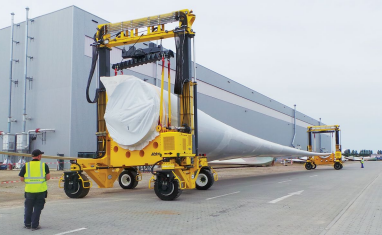
MOBILISING THE BENEFITS
According to Jarad, one of the key advantages of investing in a Combilift SC or MG is independence. “Having the ability to handle bulky loads in your own facility means you are not reliant on an external party and the uncertainty that this can bring, and therefore you will see substantial benefits in terms of efficiency, productivity and cost savings,” he stresses. “As these are mobile solutions, you can also use them for other work on site, such as moving parts into storage or handling containers.
Mining companies in particular are looking at ways in which they can make better use of outdoor storage space.” While it is difficult to put a price on the benefits the SC and MG machines afford, Jarad notes that companies in the heavy industry segment usually achieve their return of investment (ROI) within a two-year period. “ROI is dependent on the operation itself but in mining, where multiple projects are using crane hire, the ROI on an MG or SC is typically seen in two years because of the volume of work,” Jarad furthers. “In the case of NWC Steel, it comes down to being independent and flexible, which can open up that business to additional work. And also the ability to use the machine for different jobs is hugely beneficial from a productivity point of view.”
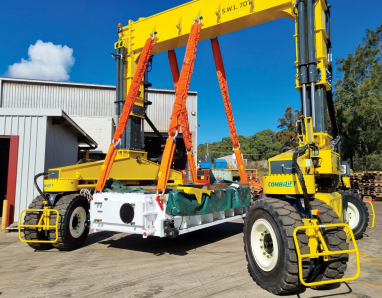
EFFICIENCY THE BIG STEEL: NWC CASE STUDY
NWC is a customer that Jarad has been working with since 2019. The Newcastle-based business has been operating since 1975 and provides specialised services to power stations and mining clients in the area, including the manufacture of heavy industrial structures and the refurbishment of equipment such as coal crushers.
“The company was started by my father Terry over 40 years ago, and we were involved – together with the OEMs – in building the local power stations,” clarifies Paul Mounter, who now manages the family business alongside his father. “We’ve been supplying the OEMs with spare parts ever since.” While NWC – which stands for National Welding and Construction – is well-established as a manufacturer of heavy industrial structures, in recent years their relationship with MB Engineering saw an increase in mining related work, including the refurbishment of raw coal crushers and screens. This led them to approach Combilift for a mobile lifting solution.
“The work involves us unloading 50 tonne crushers from the mining truck onto our site, stripping them down, repairing and reloading them,” explains Paul. “We looked at and tried different options of unloading these crushers before we got the Combilift MG, such as hiring a 200-tonne mobile crane at one point, but it was very awkward, trying to fit that large crane on our site.” As NWC is based in metropolitan Newcastle, the site space is tight.
They also considered a 50-tonne forklift but realised that wouldn’t be an appropriate fit either as it wouldn’t be able turn in a circle. The right solution came along with the MG, which was customised to meet their requirements, and has a significantly lighter footprint than the heavy lifting forklift option or crane that NWC previously used. The dimensions of the MG were configured to suit the height and width of their site entrances as well as their largest load. It has a telescopic lifting system and a multiple steering system for sharp turns. “When we customised the MG for NWC we also provided a layout of how the machine would be used on site,” underlines Jarad. “This is an important part of what we do – our customisation is not just about handling the load but how to optimise the overall logistics, so we provide a layout that demonstrates exactly how the equipment can be used onsite.
We show how it receives, manoeuvres and unloads. ”The other main requirement was that the MG would use as small a footprint as possible. “We didn’t want a hoist as such, as that would require too many moving parts, but we wanted to be able to lift incredibly heavy items and move them around our yard with ease,” adds Paul. “We also wanted to be able to park the machine out of the way when it was not in use, and not have it take up too much space.” The Combilift MG delivered on that requirement and has been an overall success. “We’re very happy with it. In fact, it’s exceeded our expectations,” enthuses Paul. “Our main benefit comes in the form of customer satisfaction from MB Engineering and their clients. Because of the criticality of these mining assets, we may get a request to repair a crusher urgently, and they’ll want to send it down the next day. Not many other businesses can react quickly enough to unload a 50-tonne crusher at such short notice. The Combilift MG allows us to do that.” Moreover, the service Paul receives from Combilift has been
second to none. “Jarad is very professional, knowledgeable and easy to deal with,” Paul concludes.
When it comes to doing heavy lifting, the Combilift Straddle Carrier and Mobile Gantry ranges can provide operators in the mining and related sectors with numerous advantages. As Jarad summarises: “No other manufacturer in the world can deliver the same level of customisation, nor cater so effectively to the diverse needs of customers in the heavy industry segment – regardless of the size of the enterprise. Which is why so many Australian customers in the heavy industrial sector are approaching us for mobile, engineered carrier solutions to help them manage their bulky loads.”

